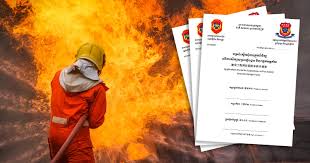Introduction
Fire safety is a critical aspect of building design and construction, particularly in a developing country like Cambodia. As urbanization and infrastructure development continue to expand, ensuring proper fire prevention measures is essential to safeguard lives and properties. The implementation of Fire Safety Design and Installation in Cambodia has seen significant improvements in recent years, but there are still challenges that need to be addressed.
Fire Safety Regulations in Cambodia
In Cambodia, fire safety regulations are governed by multiple agencies, including the Ministry of Interior, the Fire Prevention and Rescue Police Department, and the Ministry of Land Management, Urban Planning, and Construction. The Cambodian Building Code (CBC) and the Fire Safety Code outline the necessary requirements for fire prevention, detection, suppression, and evacuation procedures.
Although these regulations provide guidelines for fire safety, enforcement remains a challenge due to limited resources and a lack of widespread awareness. However, with increased government efforts and collaboration with international organizations, there has been steady progress in fire safety standards.
Fire Safety Design Considerations
Effective fire safety design involves a combination of passive and active fire protection measures. Key considerations include:
1. Fire-Resistant Building Materials
Using fire-resistant materials in construction is crucial for preventing the rapid spread of fire. Materials such as concrete, gypsum board, fire-rated glass, and metal-clad doors are commonly used in modern fire-resistant buildings.
2. Fire Compartmentalization
Fire compartmentalization involves dividing a building into sections to contain the spread of fire and smoke. Fire-rated walls, floors, and doors help in delaying fire progression, allowing occupants more time to evacuate safely.
3. Emergency Exits and Escape Routes
Buildings must have clearly marked emergency exits and evacuation routes to facilitate a quick and safe escape during a fire. Staircases, fire escapes, and illuminated exit signs should be strategically placed to guide occupants efficiently.
4. Smoke Ventilation Systems
Smoke ventilation systems, including automatic smoke vents and mechanical exhaust systems, help in maintaining visibility and reducing smoke inhalation risks during a fire. Proper airflow management is essential in high-rise buildings and enclosed spaces.
5. Fire Detection and Alarm Systems
Installing fire alarms and smoke detectors is a fundamental aspect of fire safety design. These systems provide early warning signals, enabling occupants to evacuate and emergency responders to take swift action.
Fire Protection Systems and Installation
A comprehensive fire protection system includes both suppression and prevention mechanisms. Some key components include:
1. Automatic Sprinkler Systems
Automatic sprinkler systems are essential in commercial and high-occupancy buildings. They activate when they detect heat, releasing water to control the fire before it spreads further.
2. Fire Extinguishers
Portable fire extinguishers should be strategically placed in all buildings, especially in high-risk areas such as kitchens, electrical rooms, and industrial sites. Different types of fire extinguishers (water, foam, CO2, and dry powder) are used based on the nature of potential fires.
3. Fire Hydrants and Hose Reels
Fire hydrants and hose reels provide a direct water supply for firefighters during emergencies. These systems should be regularly maintained to ensure operational efficiency.
4. Fire Suppression Systems
Fire suppression systems, such as gas-based and foam-based suppression units, are used in sensitive environments like data centers, laboratories, and industrial plants where water-based suppression might not be suitable.
5. Emergency Lighting and Signage
Adequate emergency lighting and fire exit signage are essential for guiding building occupants to safety. Backup power sources, such as generators and battery-powered lights, ensure functionality during power failures.
Challenges in Fire Safety Implementation in Cambodia
Despite improvements in fire safety measures, Cambodia faces several challenges in fire prevention and response:
-
Limited Public Awareness – Many residents and business owners lack knowledge of fire safety protocols, increasing the risk of fire hazards.
-
Lack of Trained Fire Safety Professionals – The shortage of skilled fire safety engineers and technicians impacts the proper design and maintenance of fire protection systems.
-
Inadequate Infrastructure – In many areas, fire hydrants and water supply systems are insufficient, limiting firefighting capabilities.
-
Weak Regulatory Enforcement – Fire safety codes exist, but enforcement is inconsistent, leading to non-compliance in many buildings.
-
Rapid Urbanization – With increasing construction activities, fire safety considerations are sometimes overlooked in the rush to develop new structures.
Future Prospects for Fire Safety in Cambodia
To enhance fire safety in Cambodia, a multi-faceted approach is necessary. Key initiatives include:
-
Strengthening Fire Safety Regulations – Updating and enforcing building codes with stringent fire safety requirements.
-
Training and Certification Programs – Establishing training programs for fire safety professionals and promoting awareness among the general public.
-
Investment in Modern Fire Equipment – Acquiring advanced firefighting equipment and technology to improve fire response capabilities.
-
Public Awareness Campaigns – Conducting fire drills, workshops, and educational programs to instill fire safety knowledge.
-
Collaboration with International Experts – Partnering with global fire safety organizations to improve Cambodia’s fire safety standards and practices.
Conclusion
Fire safety design and installation in Cambodia are crucial for protecting lives and properties as the country continues to develop. While there are existing regulations and systems in place, more efforts are required to improve enforcement, awareness, and infrastructure. Through proper planning, investment in modern technology, and education, Cambodia can build a safer environment with effective fire prevention and response measures.
